
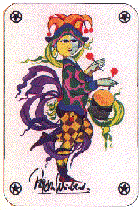
By Ben Bornstein
 |
 |
| In Playing Cards By Ben Bornstein |
Wiinblad. Printed by Piatnik of Austria in 1976. Wiinblad was a painter of Rosenthal China. |
 Artists have been involved in the design of playing cards for centuries. Unknown painters have earned a living by their design, some only designing the backs.
Artists have been involved in the design of playing cards for centuries. Unknown painters have earned a living by their design, some only designing the backs. The so called modern masters have also been involved in the design of playing cards, and some of their work has sold for large sums. William Aiken Walker (1838-1921), hand-painted a pack in 1864 during the American Civil War. Each court card showed either famous politicians, generals, or battle scenes. This pack recently sold at auction for $28,000 U.S.
The so called modern masters have also been involved in the design of playing cards, and some of their work has sold for large sums. William Aiken Walker (1838-1921), hand-painted a pack in 1864 during the American Civil War. Each court card showed either famous politicians, generals, or battle scenes. This pack recently sold at auction for $28,000 U.S. You never know when something like this will fall into your hands.
You never know when something like this will fall into your hands. One of the more well known artists, Maxfield Parrish, designed 10 packs of cards for Edison Mazda, a division of General Electric. As one of the foremost artists of his era, and his art being in demand, the 10 packs in excellent condition sold at auction for $6,000 U.S.
One of the more well known artists, Maxfield Parrish, designed 10 packs of cards for Edison Mazda, a division of General Electric. As one of the foremost artists of his era, and his art being in demand, the 10 packs in excellent condition sold at auction for $6,000 U.S.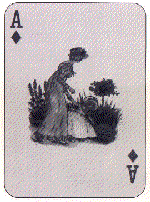
 Card manufacturers also used pictures by Norman Rockwell, Kate Greenaway, and Arthur Rackham to grace the backs of playing cards.
Card manufacturers also used pictures by Norman Rockwell, Kate Greenaway, and Arthur Rackham to grace the backs of playing cards. (Pictured at left: Kate Greenaway. Printed in China in 1975. Pictures on all cards.)
(Pictured at left: Kate Greenaway. Printed in China in 1975. Pictures on all cards.) Some fairly modern artists who designed playing cards are Salvador Dali of Spain, Alberto Vargas of Peru (known for his "Esquire" centrefolds), Gil Elvgren of the U.S.A. and Emilio Tadini of Italy, to name just a few.
Some fairly modern artists who designed playing cards are Salvador Dali of Spain, Alberto Vargas of Peru (known for his "Esquire" centrefolds), Gil Elvgren of the U.S.A. and Emilio Tadini of Italy, to name just a few. William Henry Barribal, born in England in 1873, painted until he was 83 years of age. He specialized in beautiful women, and his work was used on playing cards, posters, cigarette cards, and greeting cards. There is now a "Barribal" club in Australia.
William Henry Barribal, born in England in 1873, painted until he was 83 years of age. He specialized in beautiful women, and his work was used on playing cards, posters, cigarette cards, and greeting cards. There is now a "Barribal" club in Australia. The internationally known artist Erte, designed a pack based on Verdi's "La Traviata". Each card, individually signed, shows scenes and characters from the opera. The pack was commissioned by Alfred Dunhill of England.
The internationally known artist Erte, designed a pack based on Verdi's "La Traviata". Each card, individually signed, shows scenes and characters from the opera. The pack was commissioned by Alfred Dunhill of England.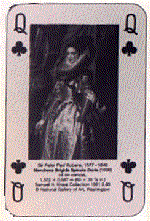
 Many art galleries and museums have produced special packs of cards. The Metropolitan Museum of Art of New York, produced a pack in 1970, which was a duplicate of a set made in 1700 in Germany. The National Gallery of Art in Washington, D.C., produced a pack with each card having a photo of a painting done by one of the great masters.
Many art galleries and museums have produced special packs of cards. The Metropolitan Museum of Art of New York, produced a pack in 1970, which was a duplicate of a set made in 1700 in Germany. The National Gallery of Art in Washington, D.C., produced a pack with each card having a photo of a painting done by one of the great masters. (Pictured at right: National Gallery of Art, Washington, D.C., 1965. Printed in Germany. Different painting on each card.)
(Pictured at right: National Gallery of Art, Washington, D.C., 1965. Printed in Germany. Different painting on each card.) A pack printed in Belgium and called "Artdeck" has 52 pictures done by great artists of the past. This pack is still available at The Museum Shop.
A pack printed in Belgium and called "Artdeck" has 52 pictures done by great artists of the past. This pack is still available at The Museum Shop. Artists of other fields dabbled in the playing card market. One of the great masters in the painting of china and porcelain, Wiinblad, designed a wonderful pack with his special kind of work on each card.
Artists of other fields dabbled in the playing card market. One of the great masters in the painting of china and porcelain, Wiinblad, designed a wonderful pack with his special kind of work on each card.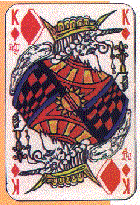 |
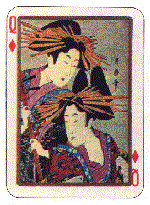 |
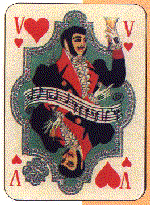 |
| Salvador Dali. Each card painted by the artist in 1969. Printed in France by Draeger Freres. | Ukiyo-E. From the Ueno Museum in Japan 1962. Different painting on each card. | La Traviata Pack. Painted by Erte 1982. Printed by Seven Arts in England. |
 The manufacturers in France are very well known for beautiful and unusual art in the playing card field. One of the best known artist designers was P. Emile Becat. He drew the faces of about 5 known packs. There may be some that are not known. The five known are: The Florentin Pack, of which only 28,000 were produced worldwide, St. Hubert's Bridge, Can Can, The Three Musketeers, and the rarest, Casanova.
The manufacturers in France are very well known for beautiful and unusual art in the playing card field. One of the best known artist designers was P. Emile Becat. He drew the faces of about 5 known packs. There may be some that are not known. The five known are: The Florentin Pack, of which only 28,000 were produced worldwide, St. Hubert's Bridge, Can Can, The Three Musketeers, and the rarest, Casanova. Most designers draw the court cards so that if turned upside down, the same character is seen. Becat went to the trouble of designing a different picture top and bottom.
Most designers draw the court cards so that if turned upside down, the same character is seen. Becat went to the trouble of designing a different picture top and bottom.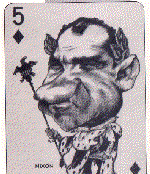
 B.P. Grimaud of France, the primary manufacturer, has produced many art packs. One special one is called Michel-Ange, and has a photo of one of the great master's works on each card.
B.P. Grimaud of France, the primary manufacturer, has produced many art packs. One special one is called Michel-Ange, and has a photo of one of the great master's works on each card. They also produced a pack called "Le Jeu de Peintres", which shows the work of 19 French artists of the modern era.
They also produced a pack called "Le Jeu de Peintres", which shows the work of 19 French artists of the modern era. (Pictured at left: World Politics. Drawings by Arturo of Spain in 1973. Double pack with caricatures of 104 different world figures.)
(Pictured at left: World Politics. Drawings by Arturo of Spain in 1973. Double pack with caricatures of 104 different world figures.) Many artists have specialized in politics. Arturo of Spain did a double pack, showing 104 major political figures. This pack done in 1973, has most of the famous and infamous people in political life of the war years and after.
Many artists have specialized in politics. Arturo of Spain did a double pack, showing 104 major political figures. This pack done in 1973, has most of the famous and infamous people in political life of the war years and after.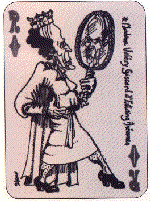
 A pack done in France by artist Eddy Muneral was actually banned in the whole country by the then president, Giscard D'Estang. The pack done in 1976, showed a caricature of his wife. While the entire pack showed people from the past and present, the president was so angry that he banned the sale of this pack in the entire country.
A pack done in France by artist Eddy Muneral was actually banned in the whole country by the then president, Giscard D'Estang. The pack done in 1976, showed a caricature of his wife. While the entire pack showed people from the past and present, the president was so angry that he banned the sale of this pack in the entire country. (Pictured at right: Le Giscarte. Caricatures by Eddy Munerol done in 1976. Banned in France by Giscarte, the president of France.)
(Pictured at right: Le Giscarte. Caricatures by Eddy Munerol done in 1976. Banned in France by Giscarte, the president of France.) Artists in most of the major countries of the world have, in one way or another, been drawn into the playing card field. Literally, thousands of prints are out there showing card playing scenes. I know of hand-drawn and painted cards as far back as 1650.
Artists in most of the major countries of the world have, in one way or another, been drawn into the playing card field. Literally, thousands of prints are out there showing card playing scenes. I know of hand-drawn and painted cards as far back as 1650. I may have about 100 art related packs in my own collection, but I am sure there must be many more out there. These packs are a wealth of beauty, and a great way to see the great works of artists, old and new.
I may have about 100 art related packs in my own collection, but I am sure there must be many more out there. These packs are a wealth of beauty, and a great way to see the great works of artists, old and new.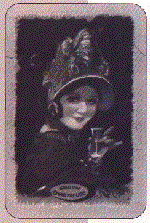
 If you are interested in collecting artist related playing cards, I would suggest that you start with some of the new ones available. As I have stated earlier, The Museum Shop has a few packs that show the work of some great artists. Art packs are also available at The Den for Men.
If you are interested in collecting artist related playing cards, I would suggest that you start with some of the new ones available. As I have stated earlier, The Museum Shop has a few packs that show the work of some great artists. Art packs are also available at The Den for Men. (Pictured at left: Green Chartreuse. Painting by Barribal. Printed by Waddington of England in 1940.)
(Pictured at left: Green Chartreuse. Painting by Barribal. Printed by Waddington of England in 1940.) If you are the type that attends flea markets and antique shops, look for the older packs that we collectors call "Named". That is, packs that have a scene with a name in black or gold at the bottom of the picture. Some quite well known artists started their trade by painting these pictures.
If you are the type that attends flea markets and antique shops, look for the older packs that we collectors call "Named". That is, packs that have a scene with a name in black or gold at the bottom of the picture. Some quite well known artists started their trade by painting these pictures. A good way to start collecting, is to join a club. I am a member of "52 + Joker", a club with about 400 members worldwide. We have annual conventions, where heavy trading takes place, and some real gems can be bought at auction.
A good way to start collecting, is to join a club. I am a member of "52 + Joker", a club with about 400 members worldwide. We have annual conventions, where heavy trading takes place, and some real gems can be bought at auction. In the future, I will write about other fields in playing cards... sports, music, advertising, and the antique group that are the pride and joy of most serious collectors.
In the future, I will write about other fields in playing cards... sports, music, advertising, and the antique group that are the pride and joy of most serious collectors. There is a love in collecting anything, but my love is the card. As the old cliche says, "Try it, you'll like it".
There is a love in collecting anything, but my love is the card. As the old cliche says, "Try it, you'll like it".